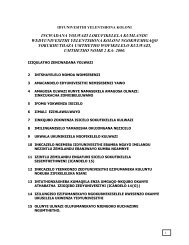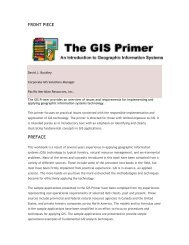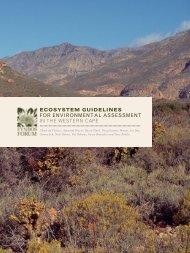Chapter 1 - University of the Western Cape
Chapter 1 - University of the Western Cape
Chapter 1 - University of the Western Cape
Create successful ePaper yourself
Turn your PDF publications into a flip-book with our unique Google optimized e-Paper software.
Map 1: Hotspots, Major Tropical Wilderness Areas, and Coral Reef Hotspots<br />
California Floristic Province<br />
Caribbean<br />
Mesoamerica<br />
Chocó-Darién-<strong>Western</strong> Ecuador<br />
Amazonia<br />
Tropical Andes<br />
Polynesia/Micronesia<br />
Central Chile<br />
Guinean Forests<br />
<strong>of</strong> West Africa<br />
Brazilian Cerrado<br />
Atlantic Forest Region<br />
Mediterranean Basin<br />
Succulent Karoo<br />
Congo<br />
Forest<br />
Caucasus<br />
<strong>Western</strong> Ghats & Sri Lanka<br />
Eastern Arc Mts &<br />
Coastal Forests <strong>of</strong><br />
Tanzania & Kenya<br />
<strong>Cape</strong> Floristic Region<br />
Madagascar & Indian<br />
Ocean Islands<br />
contribute to conservation and<br />
community development in <strong>the</strong><br />
areas being developed.<br />
It might be expected that<br />
tourism development following<br />
<strong>the</strong> principles associated with<br />
ecotourism would go hand in hand<br />
with biodiversity conservation and<br />
improvements in rural livelihoods.<br />
In many instances, tourism has<br />
been instrumental in delivering<br />
scarce funds for conservation<br />
and providing local people with<br />
an economic incentive to protect<br />
biodiversity from o<strong>the</strong>r, potentially<br />
more damaging forms <strong>of</strong> develop-<br />
Indo-<br />
Burma<br />
Mountains <strong>of</strong><br />
Southwest China<br />
Sundaland<br />
Southwest<br />
Australia<br />
Philippines<br />
Wallacea<br />
Polynesia/Micronesia<br />
New Guinea<br />
New Zealand<br />
New Caledonia<br />
BIODIVERSITY HOTSPOTS, MAJOR TROPICAL WILDERNESS AREAS, AND CORAL REEF HOTSPOTS<br />
Hotspots<br />
Open water<br />
Major Tropical Wilderness Areas No data for study year<br />
Coral Reef Hotspot Areas<br />
Scale: 1/190,000,000<br />
Projection: Robinson<br />
Data: Conservation International 2002<br />
Cartography: M. Denil<br />
© CI 2003<br />
<strong>the</strong> CBD Guidelines on Sustainable<br />
Tourism in Vulnerable Ecosystems,<br />
approved in <strong>the</strong> convention’s<br />
Scientific and Technical advisory<br />
body in March 2003.<br />
Communities that receive<br />
significant income from tourism<br />
may be motivated to conserve biodiversity.<br />
However, if benefits are<br />
small—or not sufficiently linked<br />
with conservation inputs—<strong>the</strong>y<br />
may be reinvested in activities that<br />
undermine biodiversity conservation<br />
such as livestock rearing<br />
(WCPA 2000).<br />
Sustainable tourism has<br />
emerged as a more responsible form<br />
<strong>of</strong> mass tourism development (see<br />
Box 3). In <strong>the</strong> past, traditional<br />
mass tourism developments have<br />
been a major threat to biodiversity<br />
conservation because management<br />
controls and effective planning<br />
mechanisms have been lacking.<br />
Drawing from <strong>the</strong> concepts <strong>of</strong><br />
ecotourism, namely that tourism<br />
should “conserve <strong>the</strong> environment<br />
and sustain <strong>the</strong> well-being <strong>of</strong> local<br />
people” (TIES 1991), sustainable<br />
tourism seeks to minimize<br />
<strong>the</strong> negative footprint <strong>of</strong> tourism<br />
developments and at <strong>the</strong> same time<br />
TOURISM AND BIODIVERSITY: MAPPING TOURISM’S GLOBAL FOOTPRINT<br />
5
















